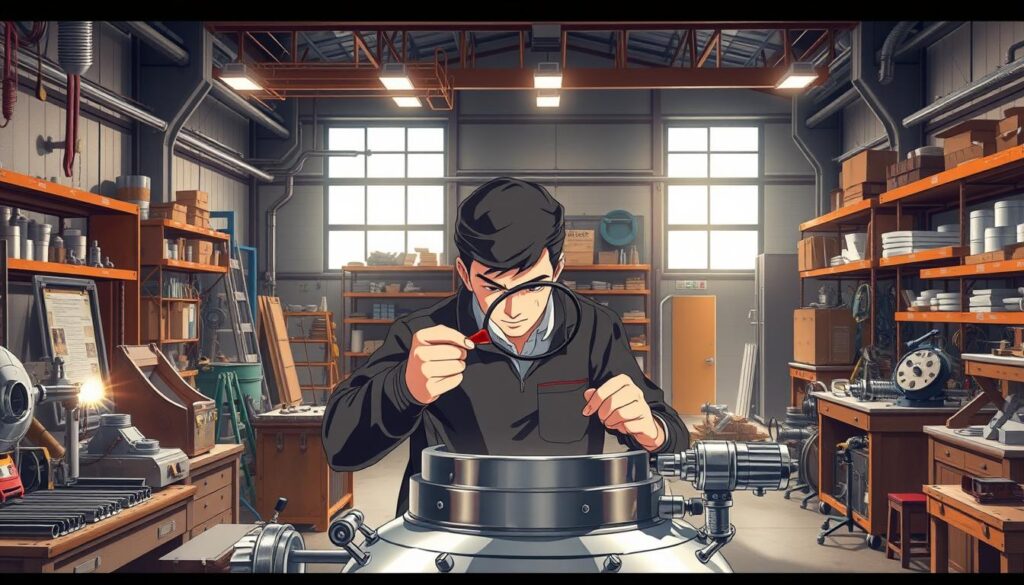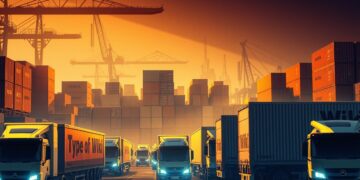Knowing the type of pipe or vessel is key for safety and efficiency. It matters in industries and homes. Materials like steel, PVC, and copper affect how well they work.
Engineers follow strict standards like ASME and ASTM. They pick designs that can handle pressure, corrosion, and temperature. The wrong choice can cause leaks, equipment failure, or safety risks.
Pressure vessels in chemical plants face tough conditions. Home plumbing uses durable PVC for drainage. The material chosen affects how long it lasts—steel is strong but needs rust protection.
This guide shows how industries and homes rely on specific types of pipes and vessels. They meet the needs of different functions.
Key Takeaways
- Material choice affects durability and safety in pipe and vessel design.
- Steel, PVC, and copper are common materials for different applications.
- Industries like oil and gas use specialized vessels to manage high-pressure processes.
- Home systems depend on correct pipe types to avoid leaks and system failures.
- Standards like ASME BPVC ensure safe design and compliance across uses.
Introduction to Pipes and Vessels in Industries
Pipes and vessels are key in both industrial and home systems. They help move and hold fluids, gases, and solids. The right piping materials make these systems work well and safely over time. The choice of material impacts how long it lasts, its cost, and how well it performs.
Importance of Material Selection
Choosing the right piping materials begins with knowing what the system needs. Important things to consider are:
- Corrosion resistance for chemical exposure
- Temperature tolerance for extreme environments
- Pressure ratings matching system requirements
Steel can handle high pressures in oil refineries. PVC is good for resisting chemicals in wastewater plants. Picking the wrong material can lead to leaks, failures, or not meeting rules.
Overview of Common Applications
Industrial uses include oil and gas pipelines, chemical reactors, and cooling systems in power plants. Home uses cover plumbing and HVAC systems. Each use needs piping materials that fit the fluid and environment.
Copper pipes are used for hot water in homes. Stainless steel is common in food processing for cleanliness. Choosing the right material balances safety, cost, and durability in all these areas.
Types of Pipes: A Comprehensive Guide
Choosing the right pipe material is key. It must match the system and environment. Pipes carry fluids, while vessels store or process materials. This guide covers top pipe types by strength, cost, and use.
Steel Pipes
Steel pipes handle high pressure and heavy loads well. They’re common in oil, gas, and construction. You can find them welded or seamless.
Coatings prevent rust in harsh environments. Their strength makes them essential in industrial settings.
PVC Pipes
PVC pipes resist corrosion and chemicals. They’re perfect for water, drainage, and irrigation. They’re light and simple to install.
Used in homes, they’re affordable for water lines and chemical setups.
Copper Pipes
Copper pipes are great for heat and plumbing. They resist corrosion and last for decades. They’re used in home water systems.
Soldered joints keep them leak-free. But, they might develop pinhole leaks over time.
Other Pipe Materials
New materials offer more choices. HDPE is chemical-resistant and flexible for underground use. Aluminum is light but expensive, used in specific systems.
Composite pipes mix materials for better durability. These options fit various needs and vessel types.
Understanding Vessels: Key Types Explored
Industrial piping systems use special vessels for tough conditions and storing materials. These structures meet strict safety and efficiency rules in many industries. Good design helps them work well with piping networks.
Pressure Vessels
Pressure vessels handle high internal pressures in industrial piping. They are made from materials like carbon steel or stainless steel. They follow ASME BPVC and API 510 rules.
They come in shapes like cylinders or spheres to spread out stress.
- Used in refineries to hold pressurized gases.
- Materials picked for resistance to corrosion and heat.
- They need regular checks to avoid leaks.
Storage Vessels
Storage vessels hold materials for a short time in industrial piping setups. They differ in size and what they can hold. Tanks can be horizontal or vertical, made to resist corrosion or lined with polymers.
- Horizontal tanks for storing liquids in big chemical plants.
- Vertical tanks for holding lots of water in treatment systems.
- Fiberglass used for storing harsh chemicals.
Process Vessels
Process vessels help with chemical reactions or mixing in industrial piping. They include reactors and heat exchangers. They work under exact temperature and pressure to keep the process safe.
- Reactor vessels for making chemicals in pharmaceuticals.
- Heat exchangers in power plants to move energy between fluids.
- Made with alloys for fluids that are corrosive or very hot.
Industrial Uses of Pipes and Vessels
Pipes and vessels are key in heavy industries. They help with important tasks in tough conditions. Their design and materials affect safety and work efficiency in areas like energy and making things.
Oil and Gas Industry Applications
In offshore drilling and refineries, pipes carry crude oil. Pressure vessels handle refining tasks. ExxonMobil uses strong steel vessels for high-pressure gas storage.
Corrosion-resistant alloys in these vessels stop failures in sour gas areas. This ensures they meet OSHA standards.
Water Supply Systems
Urban water systems use PVC and HDPE pipes to bring clean water to many. New York City’s system, for example, has big steel vessels. These are coated with epoxy to fight off corrosion from chlorine-treated water.
Good vessel making stops leaks that could harm drinking water.
Chemical Processing
Chemical plants need reactor vessels made from titanium or fiberglass-reinforced plastic. Dow Chemical uses stainless steel vessels for reactions that give off heat. These vessels keep the right temperature during making polymers.
They are welded with ASME-certified joints. This lets them handle harsh acids and high-pressure reactions.
Home Uses for Different Pipe Types
Choosing the right pipes for home systems starts with understanding pipe material selection. Different materials like PEX, copper, and PVC are used for various tasks. They help carry water and manage waste. The right choice can lower leaks, corrosion, and repair costs over time.
Plumbing Systems
Modern homes often use PEX tubing for plumbing. It’s flexible and resists freezing. Copper is still popular for hot water lines because it resists corrosion well.
For example, PEX by Uponor or Viega systems cut installation time. They also prevent mineral buildup.
Heating and Cooling
Radiant heating systems use cross-linked polyethylene (PEX-AL-PEX) to efficiently transfer heat. These materials handle temperature changes better than metal. This reduces leaks caused by expansion.
Choosing the right pipe material selection ensures steady comfort. It means you won’t need to replace pipes often.
Home Drainage Solutions
Drain-waste-vent systems often use PVC or ABS plastic. They’re good because they resist chemicals. Brands like A.O. Smith use Schedule 40 PVC in drain lines.
This choice helps prevent grease buildup. It also makes pipes last longer by resisting household chemicals.
Materials of Construction: What to Know
Choosing the right materials for pipes and vessels is key. They must meet vessel design criteria like pressure, corrosion resistance, and environment. Steel, PVC, copper, aluminum, and composites each have their own benefits and drawbacks.
Common Materials Explained
- Steel: It’s strong for high-pressure systems, often used in oil and gas. Coatings like galvanized finishes help it resist corrosion.
- PVC: It’s light and resists chemicals, great for water and non-corrosive fluids. But it’s not good for extreme temperatures or heavy loads.
- Copper: It’s excellent for heat in plumbing and HVAC. But it can corrode in harsh chemical environments.
- Aluminum: It’s light and resists corrosion, used in aerospace and food processing. But it’s not as durable under heavy stress.
- Composites: Like fiberglass-reinforced plastic (FRP), they combine strength and corrosion resistance for special uses.
Advantages and Disadvantages
Choosing materials depends on vessel design criteria like cost, longevity, and environment. Steel is strong but needs upkeep. PVC is cheap for low-pressure systems but can’t handle heat well. Composites are flexible and durable but cost more at first.
Manufacturers focus on materials that meet safety standards (like ASTM A537 for steel) and save money over time. Copper is great for heat but too expensive for many uses.
Regulations and Standards
Following industry rules keeps piping system components safe and working well. Groups like ASME, API, and ABS have strict rules. These rules help avoid big problems in important systems. Let’s look at how these standards guide your choices.
Industry Compliance Requirements
- ASME BPVC standards control piping system components in boilers and vessels.
- API rules are key for oil and gas pipelines to prevent harm to the environment.
- ABS certification checks if marine vessels are safe and last long.
Safe Use Practices
Regular checks and correct setup are key. Here’s what to do:
- Make sure all piping system components fit the project’s needs for pressure and temperature.
- Use certified welders and inspectors for risky jobs.
- Keep maintenance records to pass audits.
Not following these steps can lead to legal trouble and equipment breakdown. Always put safety first to protect people and things.
Maintenance Tips for Pipes and Vessels
Keeping pipes and vessels in good shape is crucial. They must work safely and well. The right start in making them is important, but keeping them up is key.

Regular Inspections
Here’s how to keep things running right:
- Check for rust, cracks, or damage every month.
- Do non-destructive tests yearly to find hidden problems in welds or seams.
- Look for leaks with pressure tests or ultrasonic tools.
Common Issues and Solutions
Fix these problems before they get worse:
- Corrosion: Clean the area and apply a protective coating.
- Leaks: Tighten or replace seals. Make sure weld repairs match the original.
- Structural Weakness: Use methods that fit the vessel’s design to strengthen weak spots.
Combining maintenance with knowledge of making vessels helps them last longer. Train your team on safety and follow repair guidelines from the maker.
Conclusion: Choosing the Right Type for Your Needs
Choosing the right pipes or vessels is all about balance. You need to think about material, function, and if they meet standards. This guide has shown how different types fit different needs in both work and home settings. Now, let’s talk about how to make sure your choices are safe and work well.
Summary of Key Points
The material you choose affects how long it lasts and its cost. Steel, PVC, and copper are good for different jobs, like handling high pressure or being used in homes. Following piping codes and standards keeps everyone safe in all kinds of industries. Regular checks and upkeep stop problems in systems for oil, water, or chemicals.
Recommendations for Selection
First, figure out what your project needs. Do you need something that resists corrosion, can handle high pressure, or works in certain temperatures? Make sure to check local building codes and piping codes and standards, like ASME or ASTM. For big projects, talk to engineers to make sure your materials fit and follow rules.
Both homeowners and professionals should think about lasting performance. Mix design ideas with real-world needs for systems that work well. Whether it’s for your home or a big industrial setup, choose wisely for safety, sustainability, and to follow rules.



















